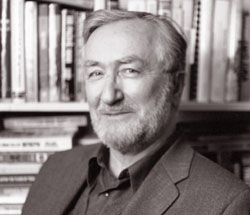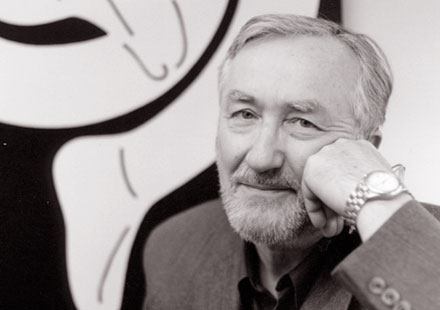Spring 2003
In a conversation with soundings, Professor John Dower discusses how his concept of cultural analysis has shifted during his career.
![]()
![]()
soundings is published by the Dean's Office of the
School of Humanities, Arts, and Social Sciences at MIT
Editor:
Jeffrey L. Cruikshank
Editorial Assistance:
Sue Mannett
Ellen Salvi
Lead Interview:
Orna Feldman
Layout and Art Direction:
Conquest
Design, Inc.
Design:
MIT
Publishing Services Bureau
Online Publishing:
Feisty Design
Proofreading:
Editorial Express
“If you are locked into a clash-of-civilizations mentality, you rarely contemplate the patterns of behavior that cut across religion, ethnicity, nationality, and 'deep history' itself to shape our present-day world.”
Professor John Dower's work focuses on the experiences of ordinary people, examining political developments within the wider frame of social and cultural dynamics.
Photo: Graham G. Ramsay.
Rethinking culture
John W. Dower, the Elting E. Morison Professor of History, is a specialist in modern Japan and U.S.-Japan relations. His award-winning books include Embracing Defeat: Japan in the Wake of World War II (1999), which won the Pulitzer Prize, National Book Award, and Bancroft Prize, among others, and War Without Mercy: Race and Power in the Pacific War (1986), honored with the National Book Critics Circle Award. Dower, who joined MIT in 1991, was also executive producer of the Academy Award-nominated documentary Hellfire: A Journey from Hiroshima (1988). In this conversation with soundings contributing editor Orna Feldman, Dower discusses his interest in comparative culture.
You've said your approach to history and scholarship has changed over the years. Would you elaborate?
When I began doing history in the 1960s and 1970s, mainstream scholarship tended to rely on official documents and the letters, diaries, and memoirs of influential men. Such resources are invaluable, particularly where they involve materials that were originally confidential. But it became increasingly clear that this approach excluded the experiences of the majority of peoples everywhere—not merely the dispossessed, but non-elites in general. And it neglected the visceral and irrational forces that also drive people and politics.
How does your more recent work address this?
I've tried to wed political developments to a broader sense of social and cultural dynamics. Take "U.S.-Japan relations," for example. In the traditional approach, this entailed focusing on state-to-state relations. My more recent work looks at activity among and between Japanese and Americans at many other levels as well. It also involves examining materials that traditional libraries and archives and scholars tended to eschew—popular songs and writings, for example, and films and cartoons, slogans and catch phrases, colloquial expressions, the experiences of ordinary men, women, and children wherever we can reconstruct them.
What contributed to this change in approach?
Events of the 1960s and early '70s were decisive. With Watergate and the Nixon tapes, for example, we saw how men of power actually talked and acted in private. It was unvarnished, crude, cynical, intemperate—a stark contrast to the public record that commonly emerges in memoranda and memoirs. With the civil rights movement, we were awakened to the discrepancies between the professed ideals of democracy and equality and the realities of race and power. And this, of course, was conjoined with the atrocious war in Indochina, where the so-called best and brightest trapped all of us in their hubris. The sheer blood lust of those years—the ability to kill literally millions of far-away people in the name of freedom and democracy—laid bare a world that formal documents alone are insufficient to deal with.
As an academic historian, your stock in trade is words. Yet throughout your career, you've put a large focus on visuals. What does the visual offer that the verbal doesn't?
My first book was on traditional Japanese design, and I remain strongly attracted to fine arts and craftsmanship. In time, however, it became clear that all sorts of visual materials—not just the high or fine arts—can be used to illuminate social and cultural and even political dynamics. Graphic images shape as well as mirror cultures. They reveal worlds that words alone can not convey. They are wonderful "texts" for us to analyze, just as we analyze written documents—but it took a surprisingly long time for historians to recognize this.

Professor Dower and Professor Shigeru Miyagawa are creating an online visual record of Japan's opening to the outside world in the 19th century.
Photo: Graham G. Ramsay.
How do you integrate this approach into the 'Visualizing Cultures' project you've just launched with Professor Shigeru Miyagawa?
The visual record of all cultures is enormous, especially from early modern times when images were reproduced in volume for popular audiences. Woodcuts, engravings, lithographs, photographs, posters, advertisements, postcards, cartoons, and films all emerged as part and parcel of modern mass culture. We can literally see how people viewed not only themselves, but also social, ethnic, and foreign "others."
But how can you share these riches? We use slides in the classroom and a smattering of illustrations in books. We mount specialized exhibitions with fine catalogs. But the number of these shared images and their audience remain minuscule. This is where the Web offers a phenomenal opportunity. In our new course, Professor Miyagawa and I, with the assistance of MIT's OpenCourseWare initiative, are attempting to put online the visual record of Japan's opening to the outside world in the 19th century. This is our case study for "visualizing cultures" more generally, and eventually it will involve thousands of graphics drawn from both Japanese and non-Japanese sources. At the same time, we are trying to push the envelope in marrying graphics to rigorous analysis in a way that will be a model
for people working on other historical and cultural projects. Technically as well as conceptually, it's a steep learning curve right now, and very exciting.
Talk a bit about how your concept of culture has changed over the years.
In fields like mine, in particular, we used to focus on "Culture" with a capital "C"—East versus West, for example, or Judeo-Christian versus Islamic or Confucian or Buddhist or Asian or Oriental "civilization." We still do this with our trendy "clash of civilizations" rhetoric. My initial attraction to Japan was very much tied up with Zen aesthetics, and I do appreciate these high cultures. Increasingly, however, I find greater challenge and pertinence in the "small-c" cultures that cut across "capital-C" boundaries—cultures of war and peace, for example, or cultures of authority, hierarchy, patriotism, mass mobilization, victim consciousness, consensus, protest, creativity, kindness, what have you.
What makes this kind of study more interesting?
Cultural analysis of the "capital-C" sort almost always stops at a rarefied level of abstraction and idealization. It also tends to discourage genuinely rigorous cross-cultural analysis and encourage instead a simplistic "on the one hand, on the other hand" mindset that fixates on differences rather than similarities among peoples and cultures. We constantly encounter this sort of stereotyping: "Whereas Westerners have a deep tradition of respect for individualism and human rights, Oriental peoples are consensual and group oriented, and do not place great value on the individual." What a gross level of generalization! We homogenize and romanticize ourselves, gloss over a few millennia of our actual history, turn "the Rest" into a monolithic and unchanging entity, and season the whole mix with an undisguised sense of moral superiority. And, of course, non-Western cultural essentialists—including many Japanese—buy into this same sort of "clash of civilizations" mentality from their own perspectives. It makes for bad history and a parochial understanding of the world.
How would this apply to current affairs?
Take the way so many Americans, including the mainstream media, have responded to September 11. We postulate an equation between the terror bombing of civilians and fundamentalist Islamic disregard for human life, and contrast this to our own humane Judeo-Christian tradition. But this is nonsense. By the end of World War II, major combatants in the Allied as well as Axis camps were targeting civilians to destroy enemy morale, and it was the United States itself that raised terror bombing to an art during the last year of the war against Japan. American airmen, who referred to their air raids as "burn jobs," incinerated over sixty cities before the atomic bombs were dropped on Hiroshima and Nagasaki. Indeed, while Americans routinely compare the crimes of September 11 to Japan's attack on Pearl Harbor sixty years earlier, an article buried in the New York Times evoked this contrary analogy in a striking way. It reported that prior to September 11, the C.I.A. intercepted "a cryptic message . . . from a member of Al Qaeda, who boasted that Osama Bin Laden was planning to carry out a 'Hiroshima' against America." But even while appropriating for the World Trade Center site the terminology of "Ground Zero" that previously was used in reference to Hiroshima, most Americans simply cannot process the terrible logic of this analogy.
If you are locked into a clash-of-civilizations mentality, you rarely contemplate the patterns of behavior that cut across religion, ethnicity, nationality, and "deep history" itself to shape our present-day world. In this case, these would include cultures of power, violence, terror, and indoctrination—shared cultures, to our shame, of indifference to the suffering of others. Of course there are differences, including cultural differences in the more traditional sense. But these are not, in and of themselves, determinative.
You paint a dark picture.
Well, these are dark times. In Embracing Defeat, I dealt at length with the cultures of "peace and democracy" that the Americans promoted and most Japanese embraced in the years immediately following Japan's defeat in World War II. We can point to a great deal that is bright and constructive in recent history, too. Now, however, we seem imperiled, from all sides, by appalling cultures of violence.
![]()
Copyright © 2003 Massachusetts Institute of Technology

